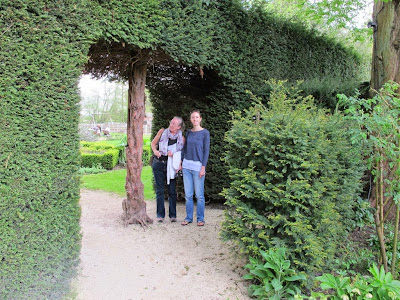Please click on any picture for a larger image.
We had Monday lunch al fresco at the Crown, Peopleton
In the peace broken only by the occasional passing car and the rooks cawing in the rookery behind the thatched cottage across the road, we enjoyed an excellent light lunch in the sunshine before visiting our daughter on our way to the lovely Windrush B&B in Broadway
Monday evening was spent with Claire at The Mount Inn at Stanton, just south of Broadway (Dave, her partner, is working away). The views looking out from the pub and the terrace are stupendous - across the local small hills and the Severn valley to the Malvern hills beyond.
Next morning I had my traditional day at the Gloucester Warwickshire Railway. Our locomotive for the day was a Great Western '42xx', the only 2-8-0 tank engine class to work in UK. Restored here at Toddington this one, 4270, like the rest of the class, spent its working life hauling heavy coal trains in the South Wales valleys.
The least attractive aspect of being steam loco footplate crew; 'going under' to couple up the loco to the coaches and connect the vacuum and steam heat bags ('bags' being the railwayman's term for the heavy hoses visible in the picture)
The view from Toddington footbridge; steam train for Cheltenham Racecourse on the left, Diesel Multiple Unit (DMU) for Laverton Loop on the right
4270's driver briefs the fireman. Or maybe they are just wondering where their mash of tea has got to!
4270 sits dappled in sunlight at Toddington on Tuesday morning
I rode the steam train down to Cheltenham Racecourse station (the southern terminus of the line), and back up to Laverton Loop, the present northern terminus, then back to Toddington. From Laverton, Broadway Tower can be seen on the horizon on the edge of the Cotswold ridge.
4270 runs round its train at Laverton Loop, for the return to Toddington and on to Cheltenham
I left the train at Toddington and had a light lunch in the cafe there before joining the DMU for an afternoon run up and down the line. Here's the view from the DMU at Toddington station looking towards Winchcombe (the intermediate station on the way to Cheletenham).
The DMU crew (driver and passed second man, training as driver) were good company on the run south. The driver was an ex-BR signalman so as a signalman myself at Consall on the CVR we had an interesting chat about signalling on this railway and elsewhere. Here we approach Cheltenham Racecourse, with the bracket signal off for the loop (the platform line, to the left).
On the return journey we crossed the southbound train (hauled by 4270) at Winchcombe loop
North of Toddington on Stanway Viaduct, seen here from the DMU cab
The end of the line - for now! A parked ballast waggon marks the northern point of the GWR beyond the headshunt for Laverton Loop. However the GWR is heading for Broadway! Already the five road underbridges between here and Broadway have been restored, and it only remains to re-lay the track, complete the rebuilding of Broadway station, and install the signalling before heritage trains once again run into the town.
Tuesday evening was spent at The Fleece Inn at Bretforton (behind Chris and Claire above). The building is owned by the National Trust, but unfortunately the pub business isn't, so I didn't get my NT volunteer discount! But never mind, the meals were superb (and the ale!), well worth paying full price for.
Claire at our table at The Fleece
This is Claire's cat, Nigel. Quite a character!
Wednesday brought the best weather of the week. After a lovely breakfast at The Windrush B&B we took a stroll into Broadway, still quiet before the coach loads of tourists arrive from mid morning onwards
Signpost in Broadway, on the Wychavon Way
Chris in Broadway
From Claire's house we went on to a national Trust property at Caughton Court, near Alcester. Here's Chris and Claire heading for the gardens.
The rear courtyard of the House at Caughton Court
Chris and Claire in the walled garden
After lunch we did a tour of the house, including climbing up to the Tower, with its great views. This is looking towards the courtyard.
Here's the view the other way, with a bronze owl keeping watch!
Looking towards the original church (now C of E, post reformation when the Catholic Throgmortens of Caughton had to take Mass in a secret private chapel in the House). In the distance is the post-reformation Catholic church.
Shades of Manchester Town Hall last Saturday. A spiral staircase led up to the Tower. This one was much shorter than the near 300 feet of climbing at Manchester, but was two-way!
The former secret Catholic chapel, later a drawing room
Chris and Claire in front of Caughton Court
Wednesday evening was spent at the Red Lion, Ilmington. A lovely basic country pub with good food.
Thursday dawned wet, the first rain of the week. After the usual excellent 'Windrush' breakfast we headed over to Claire's house to say 'by for now' to her and Nigel.
The journey home was less wet than forecast, and we look forward to doing it all (or something similar) next year.
.






























































